The kingdom of Bhutan, approximately the size of 47,000 square kilometers (18,147square miles) is idle on the southern slopes of the Eastern Himalayan by China in the north and Indian states of West Bengal and Assam in the south. Bhutan’s landscape ranges from subtropical plains in the south to the sub-alpine Himalayan Mountain in the north.
The road entering to Bhutan is through Phuentsholing and samtse, in the south, through Gelephu, in the central region and Samdrup Jongkhar, in the east. The other option is to fly till Paro by either Drukair or Bhutan Airlines, two carriers that operate in Bhutan at present. Paro is the only international airport that covers the destination like Bangkok, Dhaka, Kathmandu, Delhi, Kolkata, Bagdogra and Guwahati,
As per the policy Tourism Council of Bhutan (TCB), all tourists to Bhutan are required to arrange all tours and treks through registered Bhutanese Tour agents or one of their international partner and all visits are to be guided by licensed Bhutanese guides.
All International tourists traveling to Bhutan (except Indian) must obtain a visa clearance. Visas are provided by your licensed Bhutanese tour operator. While Indian nationals are not required to get a visa but must obtain a online permit prior to arrival
All International tourists traveling to Bhutan (except Indian, nationals) are levied to SDF (sustainable Development Fee of USD 200 per person per night and INR 1200/- per person per night for Indians, which includes the Visa fee too for Both.
Months of March, April, May (spring season) and September, October, November (autumn season) are high/Peak season for the tourists. The months of June, July, August (summer season) and December, January, February (winter season) is usually a low season for the tourists. The winter months are cold at night, but the days are quite warm with bright and clear blue skies. In the summer season, Bhutan receives heavy monsoon rain causing difficulty in traveling sometimes.
Irrespective of the season, USD 200 Per head per night and INR 1200/- per head per night has to be paid as government royalties by international travelers and by Indian national respectively. And the other Travel expenses depends on your preferences of tour types and duration of your stay in Bhutan
Bhutanese currency is known as the Ngultrum. It has the same value as the Indian currency is known as rupee which is widely accepted in Bhutan. All the international tourists must make payment in the dollar. The transactions of foreign currency are done in Bhutan National Bank,
There is no limit to the number of tourist entering Bhutan but The Royal Government of Bhutan adheres strongly to the principle “High Value, Low Impact/volume” to guide all the tourism activities in a country and a means of achieving socioeconomic development especially a developing country like Bhutan. Tourism was founded with a vision “To promote Bhutan as an exclusive travel destination based on GNH values and middle path ideologies.”
Bhutan is undeniably the safest country for any tourists. Bhutan has been gaining popularity and everyone’s dream destination. Bhutan is a Buddhist country and strongly believes in the law of karma literally means “action” or “doing” and the consequences it brings.
Bhutan is culturally known for its spiciness and the consumption of rice is seen high in Bhutan. Chilies are the main ingredient and are generally acceptable favor in any occasion in Bhutan. Popular Ema-Datsi, (made with chilies and cheese) is national curry in Bhutan. Western and Indian cuisine are also in wide varieties almost everywhere in hotels/restaurants.
Almost all the Bhutanese from kindergarten speaks English. Bhutanese gives equal importance to English as that of Dzongkha (the official language of Bhutan). Further, majority of the people understands and can speak Hindi too.
Do not hesitage to give us a call. We are an expert team and we are happy to talk to you.
(+975) 17264398 | 17479473
[email protected] | [email protected]
